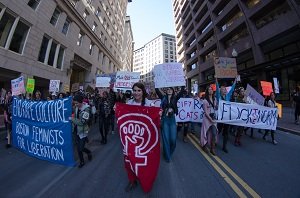 There have been three waves of feminism. The first one was the suffrage movement in the late 19th and early 20th century. The second wave occurred is associated with the 1960s liberation movements, and the third wave of feminism has started about 20 years ago, in the 90s. While all these movements are united by a common goal of women’s equality in all spheres of life, the three waves differ according to the conditions and demands of a certain time period. Thus, the third-wave feminists deal more with the issue of equal opportunities in the socially diverse environment. The main features and goals of this movement are viewed below.
There have been three waves of feminism. The first one was the suffrage movement in the late 19th and early 20th century. The second wave occurred is associated with the 1960s liberation movements, and the third wave of feminism has started about 20 years ago, in the 90s. While all these movements are united by a common goal of women’s equality in all spheres of life, the three waves differ according to the conditions and demands of a certain time period. Thus, the third-wave feminists deal more with the issue of equal opportunities in the socially diverse environment. The main features and goals of this movement are viewed below.
The third-wave feminists were inspired by the works of Amy Richards and Rebecca Walker. The authors focused on the aspect of social inclusion of the previously excluded groups in terms of sexual orientation, race, economic class, or lifestyle. While the second-wave feminists were advocating rights and equal opportunities for all women, they were criticized for being too white middle class-oriented. Therefore, the feminists of the third wave strive to expand the ideas from the 60s and 70s onto the broader and more diverse population.
Another distinction between the second and the third waves is that following the main set of feminist rules established in the 60s becomes unnecessary with the third wave. Thus, while women used to emphasize their right to control their reproductive behavior or abstain from wearing makeup, the current ideas expand this to the discourse regarding the pharmaceutical and cosmetic industries, the exploitation of the female image by those, and the inequality within the industries themselves. At the same time, it is fully acceptable for a third-wave feminist to wear makeup, for example. They try to look at every problem from different angles, through the eyes of women with different sexual orientation, race, social, cultural, and political standing.
There are some discrepancies within the third-wave feminist movement regarding gender differences between men and women. Thus, in her Live Science article from 2011, Natalie Wolchover underlines that such differences have a genetic cause, which makes it natural that men and women have different lifestyles, ways of reasoning, and goals they pursue. At the same time, other view differences between genders as a socially conditioned construct which has little to do with human biology. Therefore, they consider women and men as absolutely equal, which should mean that differences between the genders in terms of social status, pay, or working conditions.
Third-wave feminists can often get criticized for being outdated when they talk about gender inequality and draw the women-men payment ratio. The statistics from the Institute for Women’s Policy Research suggest that, on average, women make only 77% of what men earn. However, comparison of the wages across the same industry does not provide such a discrepancy; in fact, the four biggest industries show only 4% difference in favor of men. The 33% difference is the result of the labor inequality, as some areas are considered less prestigious than others and, subsequently, less paid. Third-wave feminists should be looking into the reasons behind this.
Some people believe that there is no inequality left between genders, and that the government has ensured equal opportunities for all. They also see the third-wave feminists as an aggressive group who strives towards the dominance of one sex over another, while covering it with the gender equality talk. However, while the inequality problem is solved (partially or completely) in developed countries, there are always less economically and socially developed societies, as well as underprivileged groups within developed societies, in which such problems still exist. Thus, the initial focus on diversity makes third-wave feminists not ordinary men-fighters, but a force that facilitates positive social changes.
References
- Code L. Encyclopedia of feminist theories. Taylor & Francis, 2000.
- “Feminism”. Oxford English Dictionary (3rd ed.). Oxford University Press, 2012.
- Gilligan C. In a different voice: psychological theory and women’s development. Cambridge, Mass.: Harvard University Press, 1993.
- Leidholdt D, Raymond JG. The Sexual liberals and the attack on feminism. New York: Pergamon Press, 1990.
- Patai D. “Policing the academy: “Anti-feminist intellectual harassment””. Professing feminism: education and indoctrination in women’s studies, Lanham, Maryland: Lexington Books, 2003.
- Randall V. “‘Feminism'”. In Marsh, David; Stoker, Gerry. Theory and Methods in Political Science. Basingstoke: Palgrave Macmillan, 2010.
- Smith BG. Global feminisms since 1945. Psychology Press, 2000.
Whelehan I. Modern Feminist Thought: From the Second Wave to ‘Post-Feminism’. Edinburgh: Edinburgh University Press, 1995.
